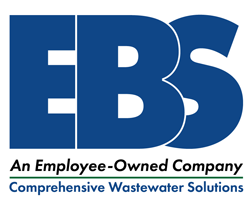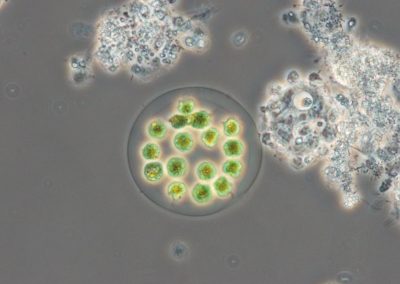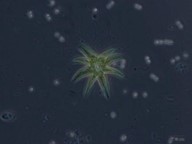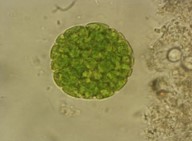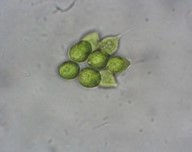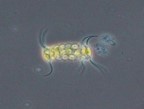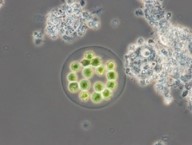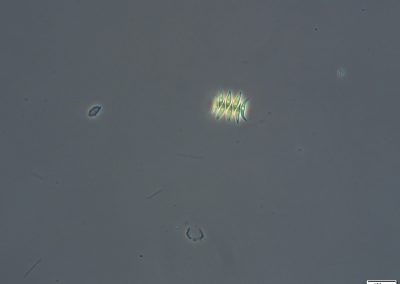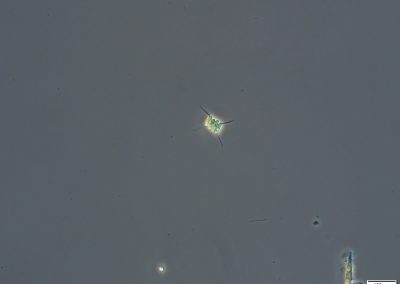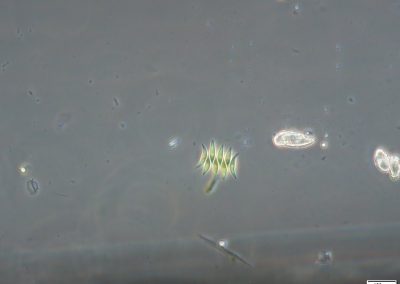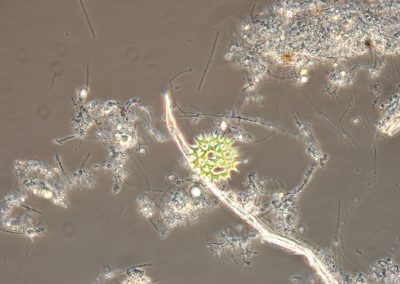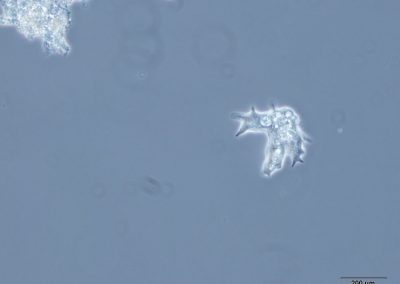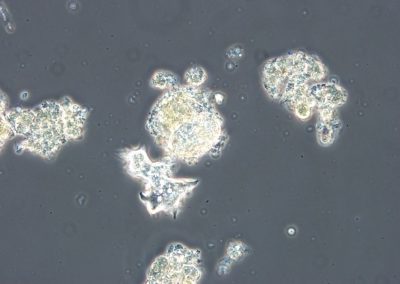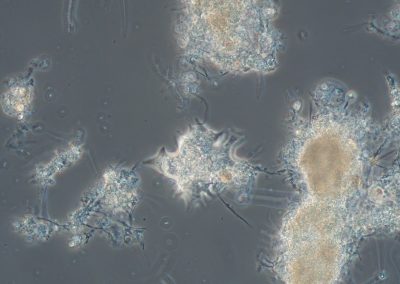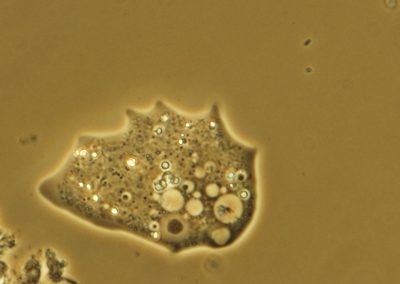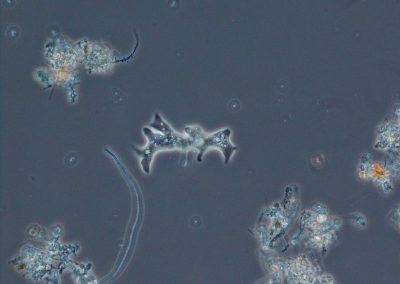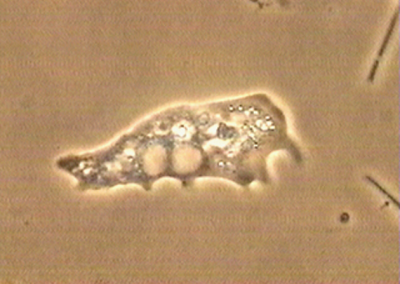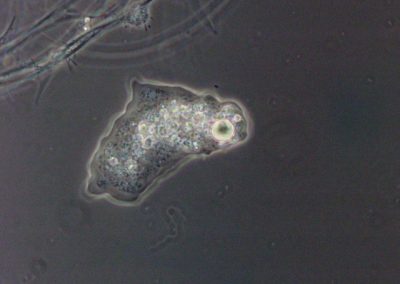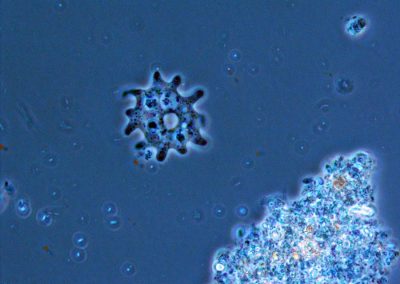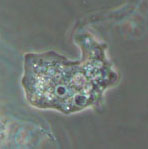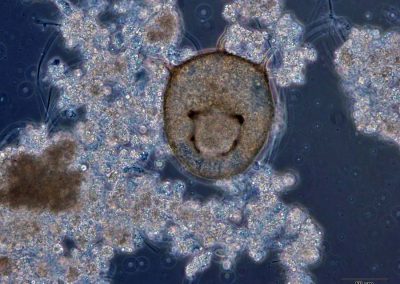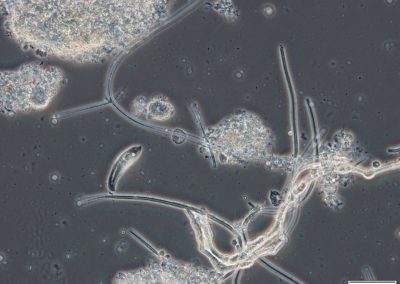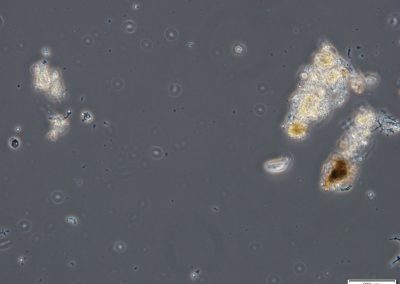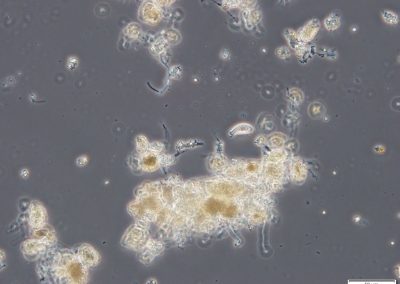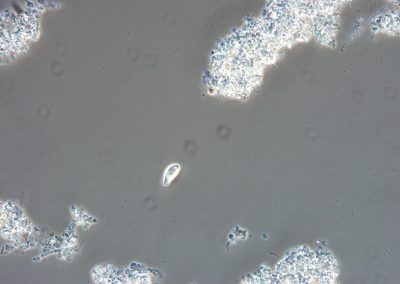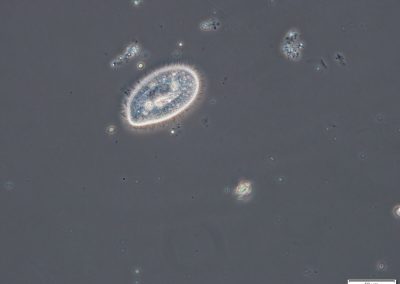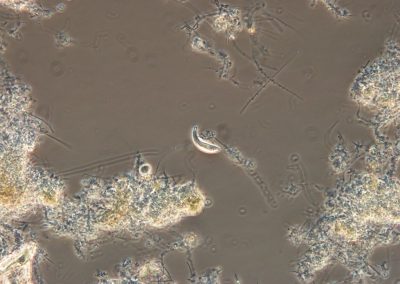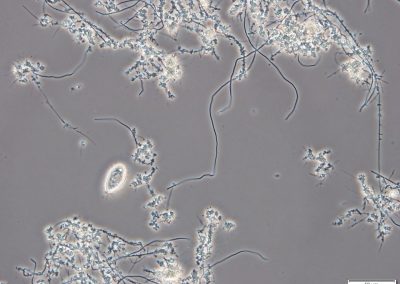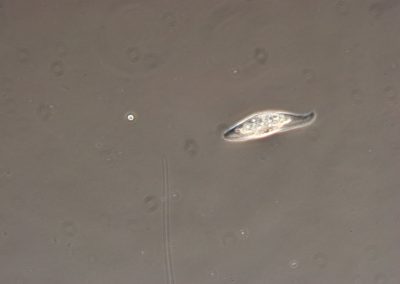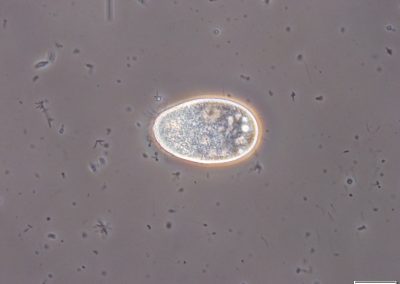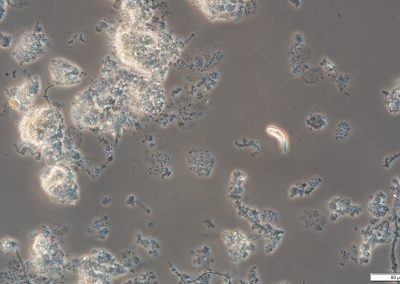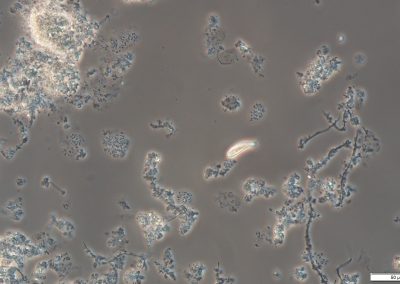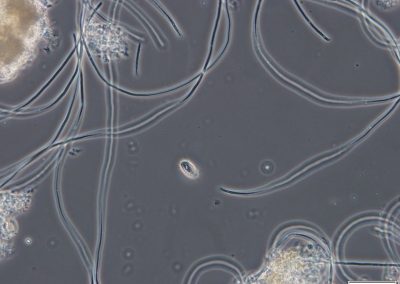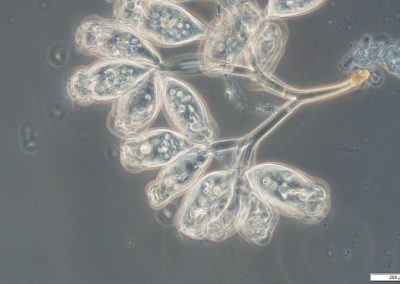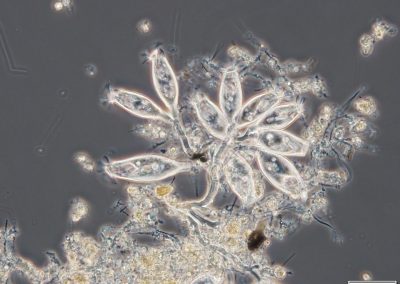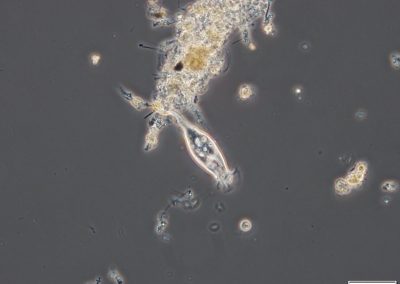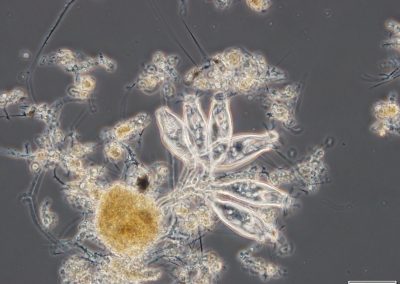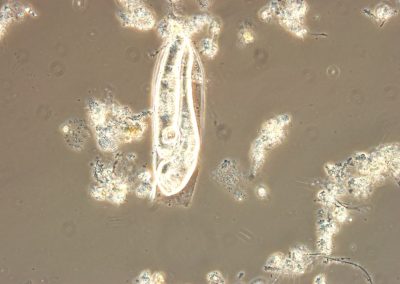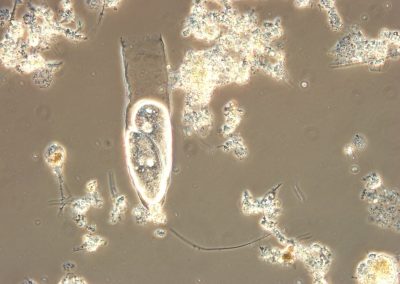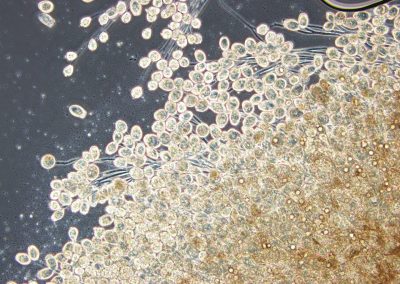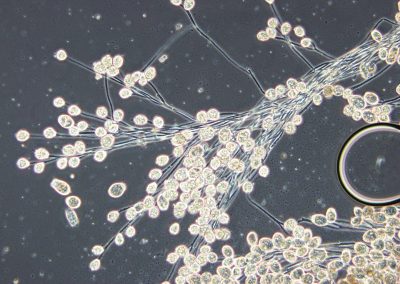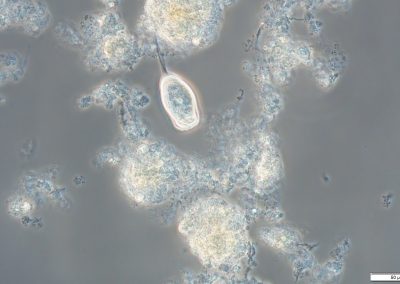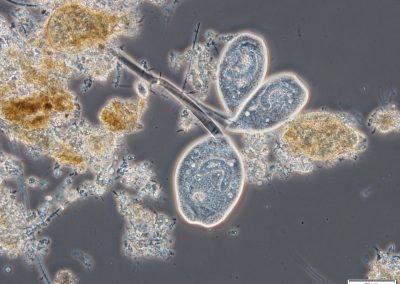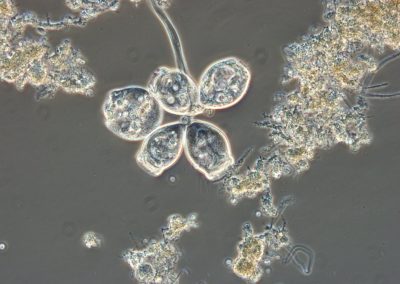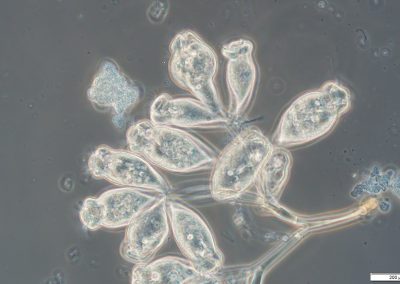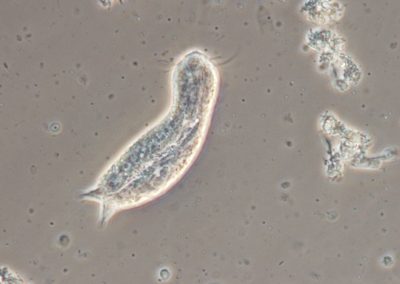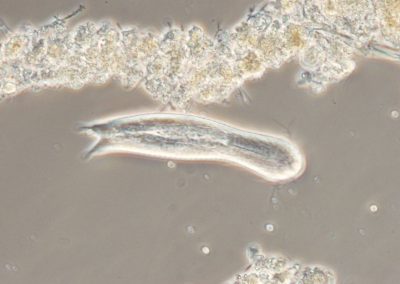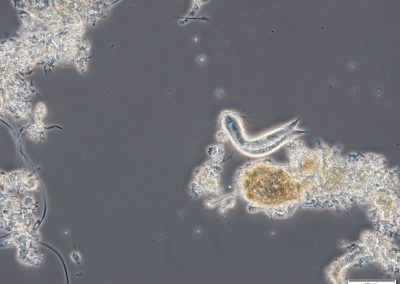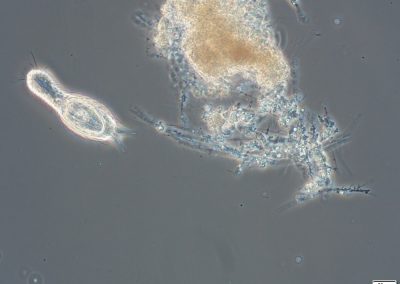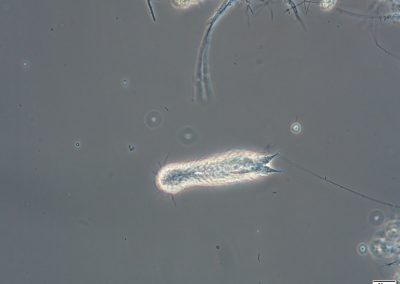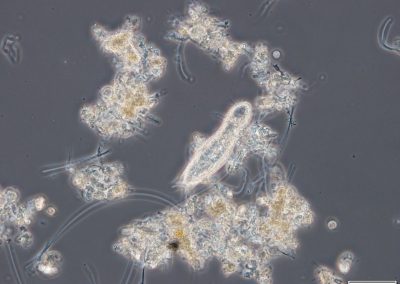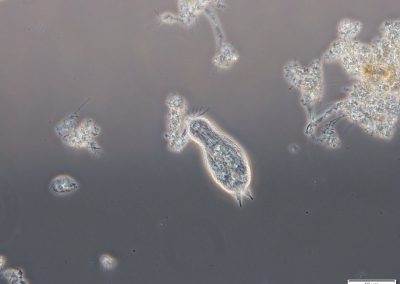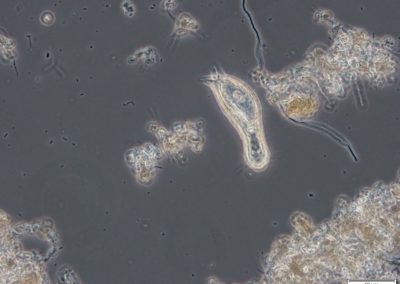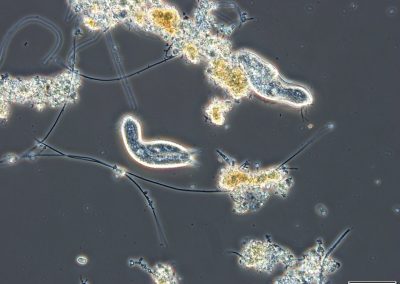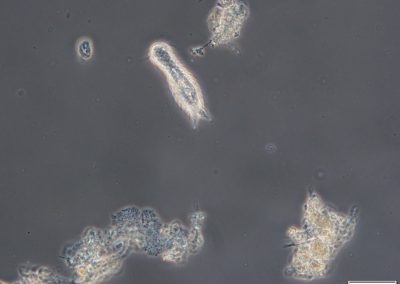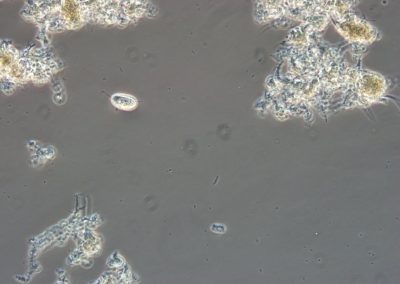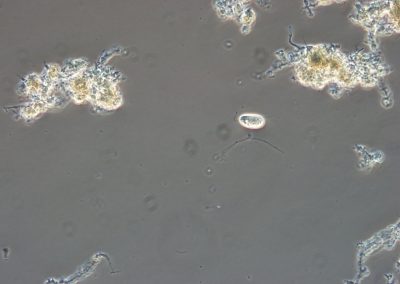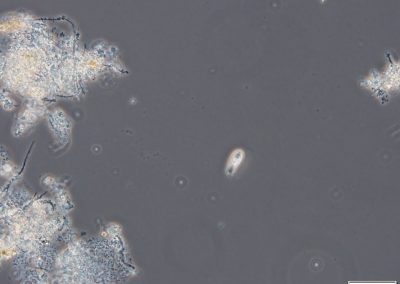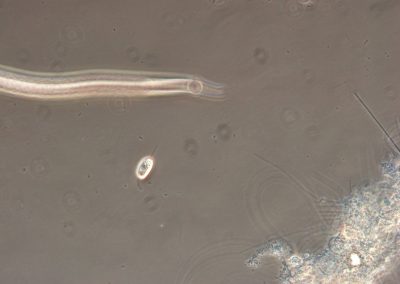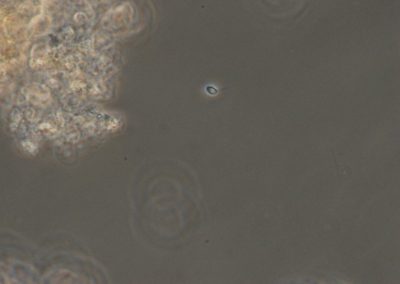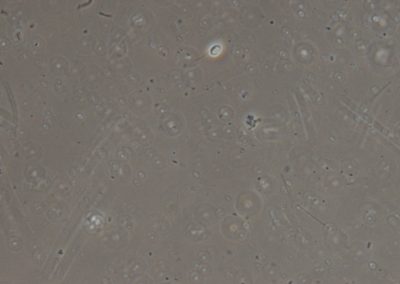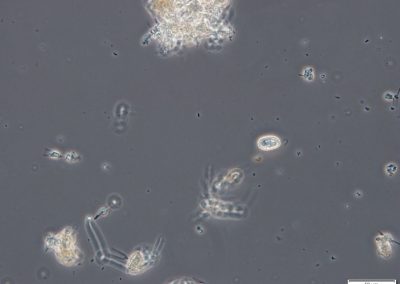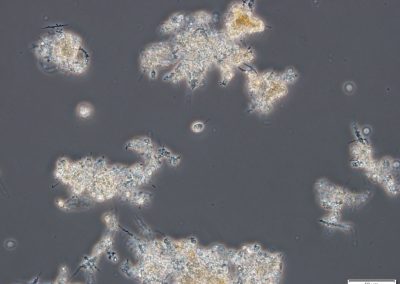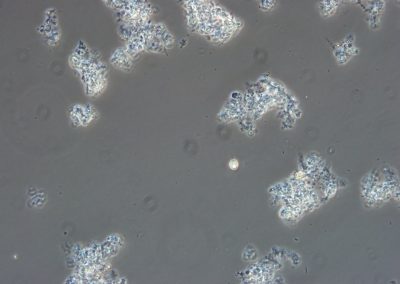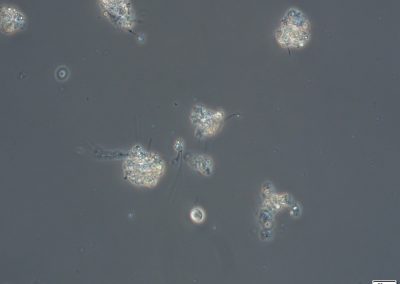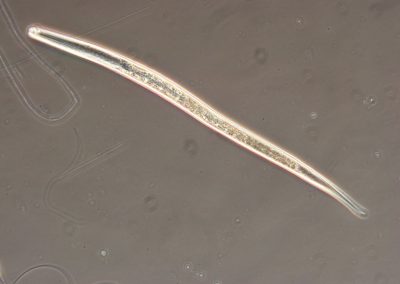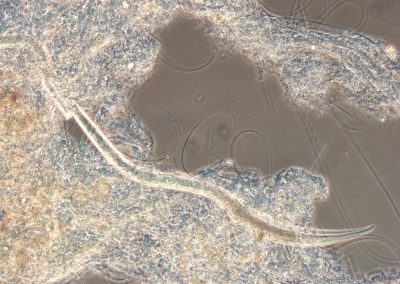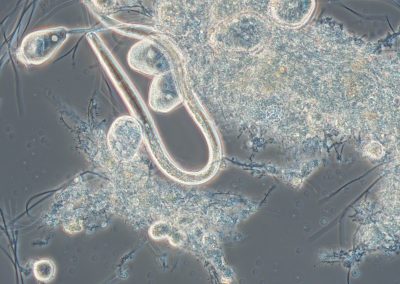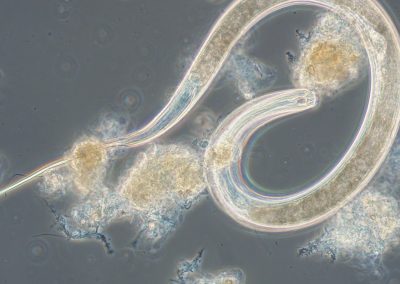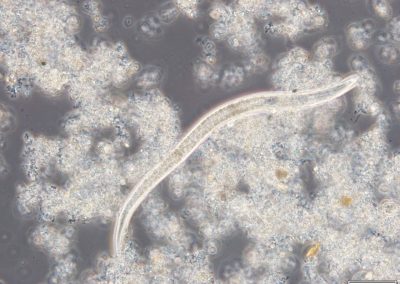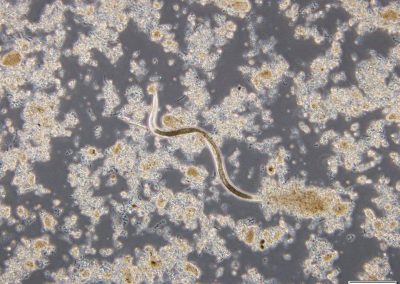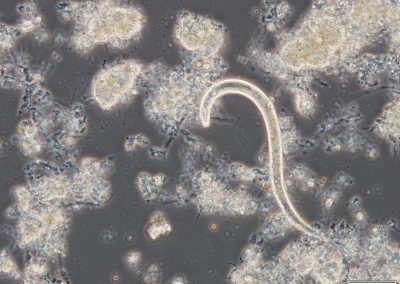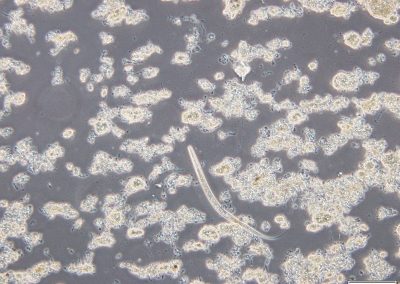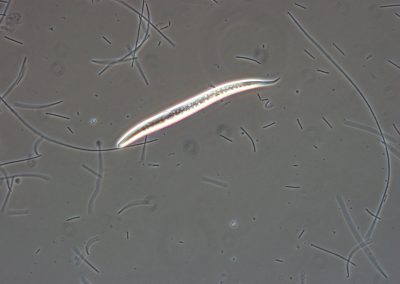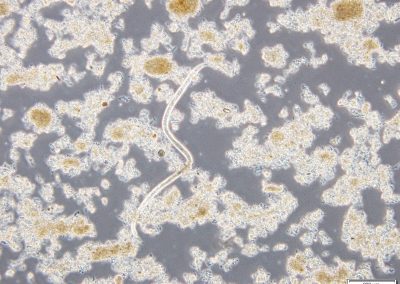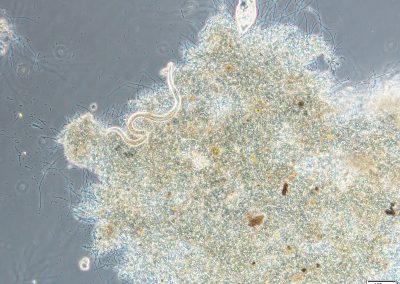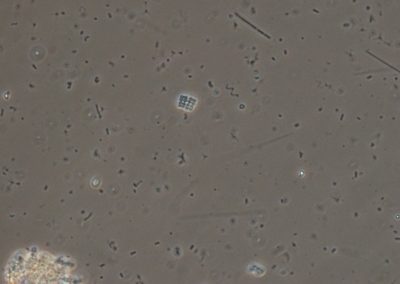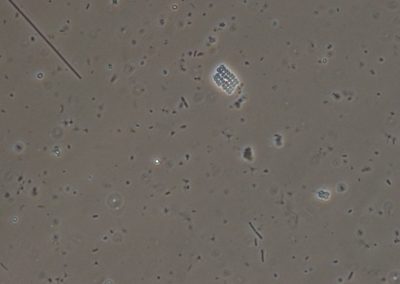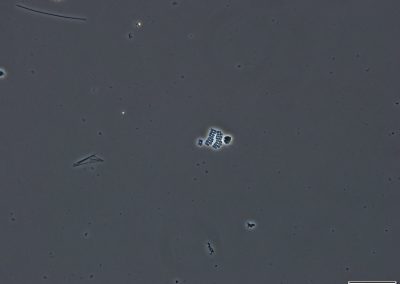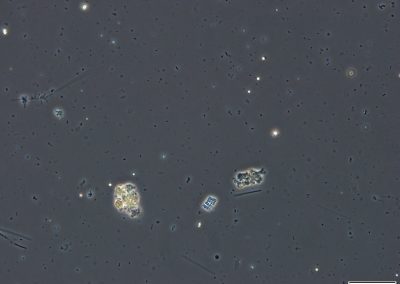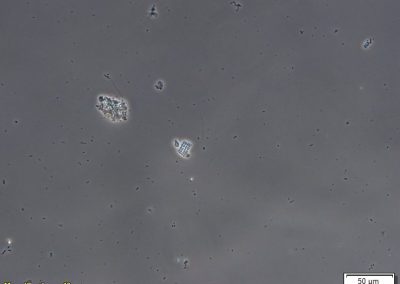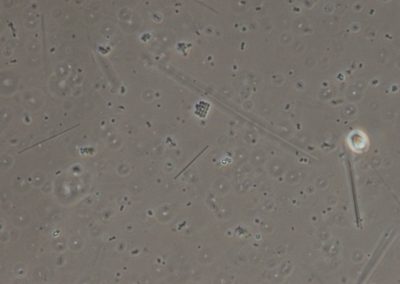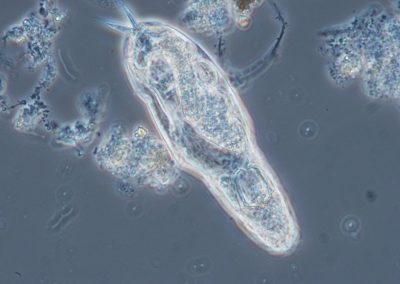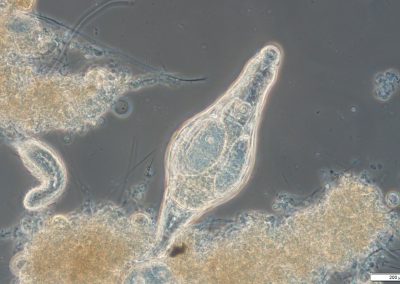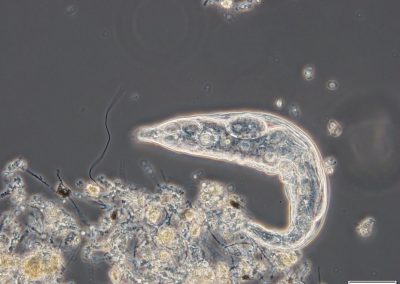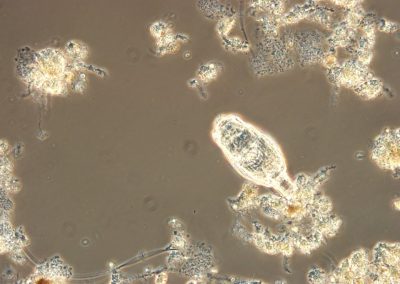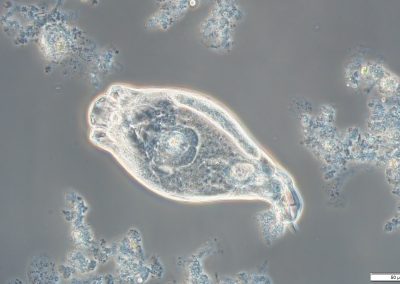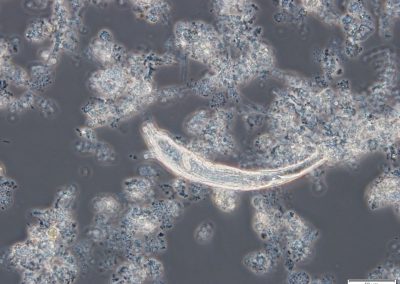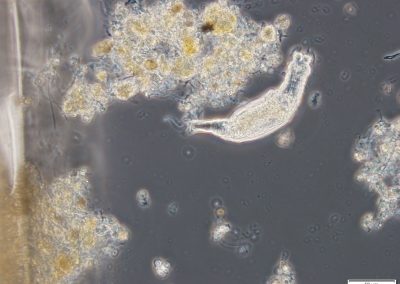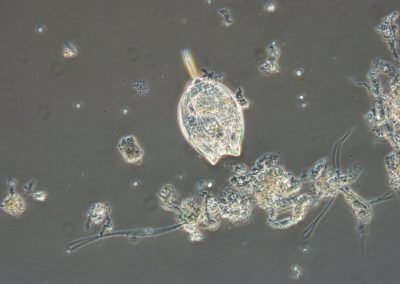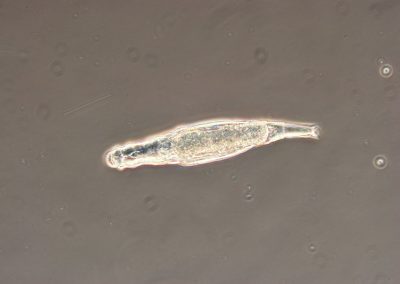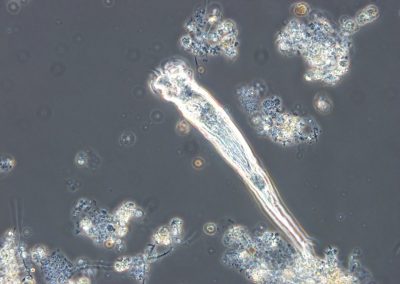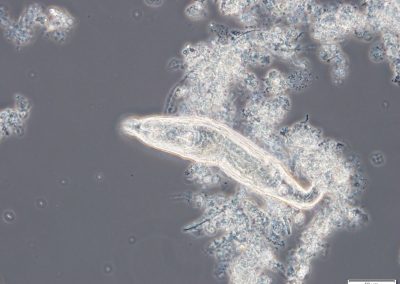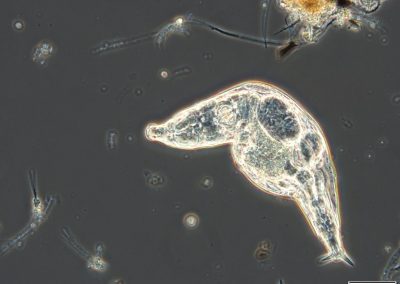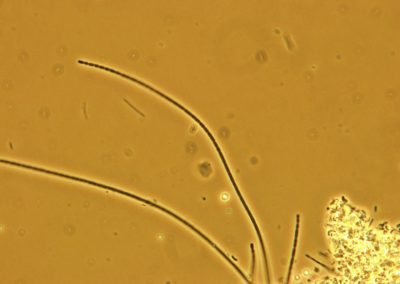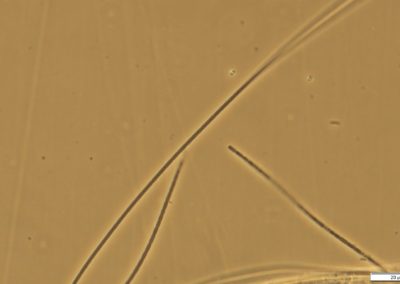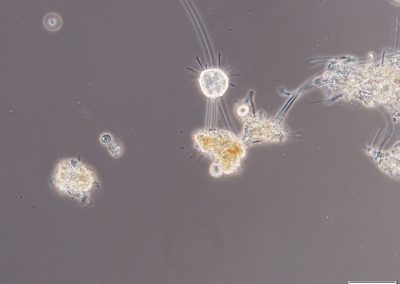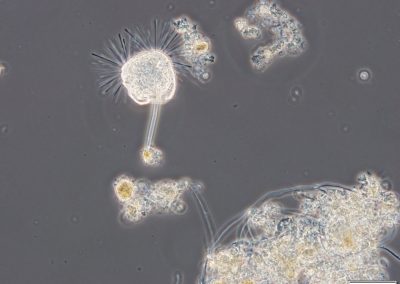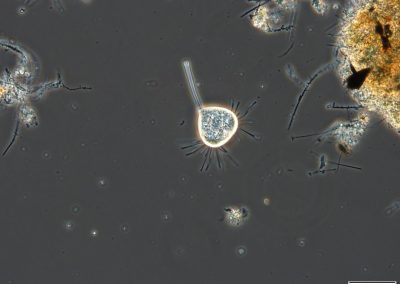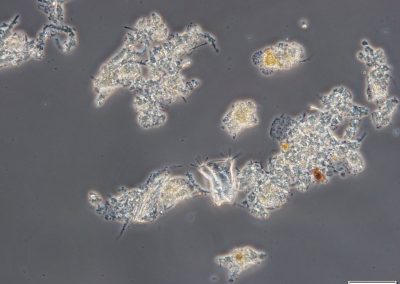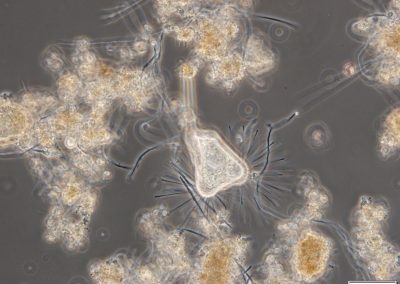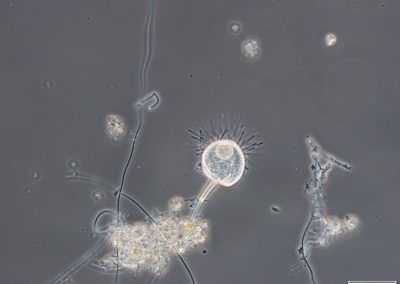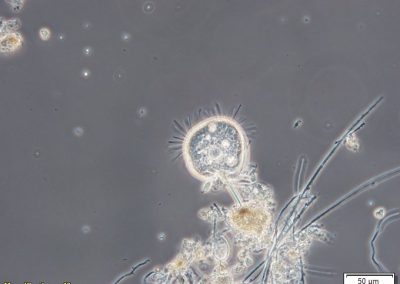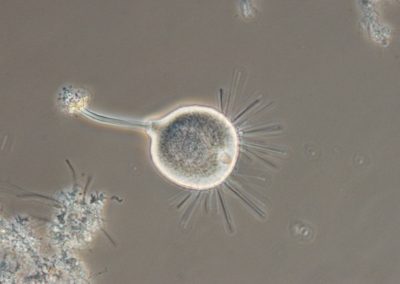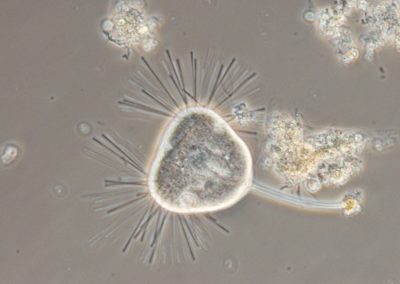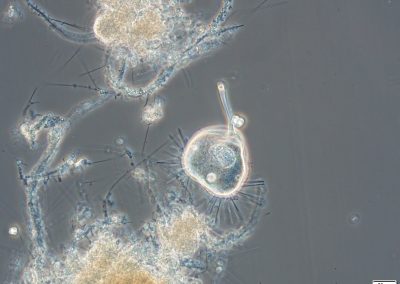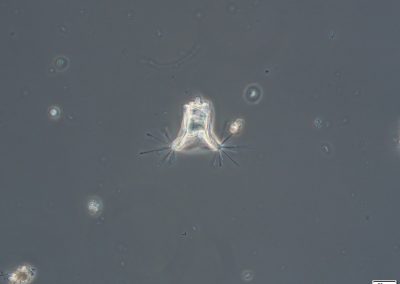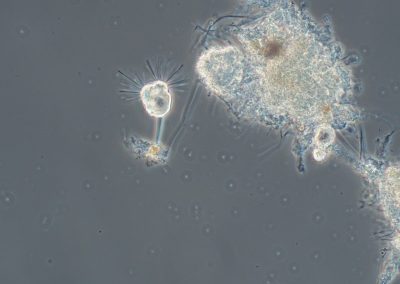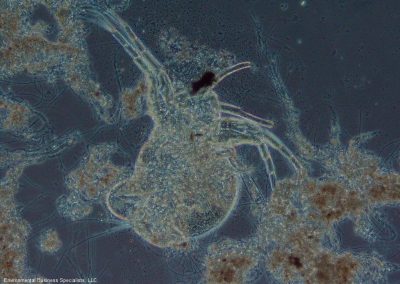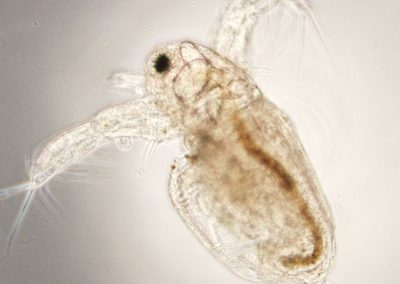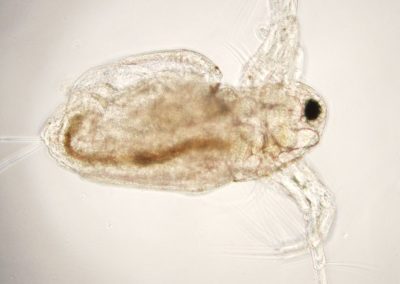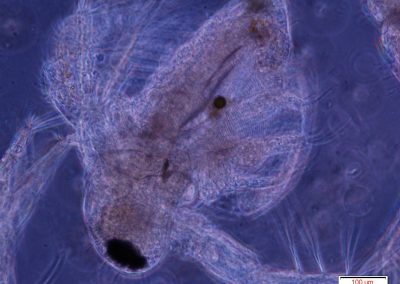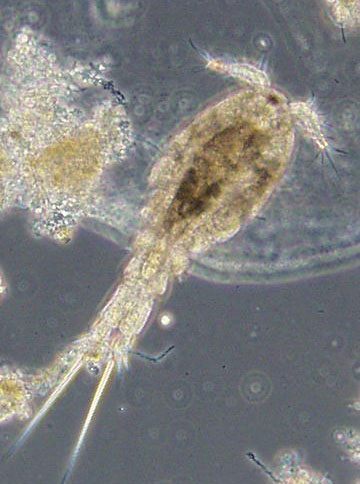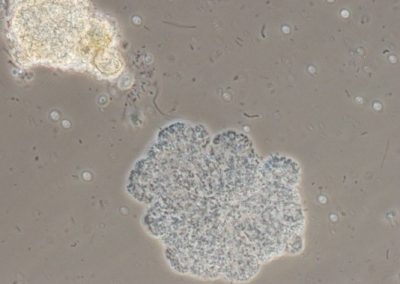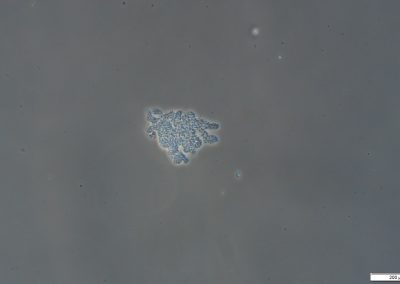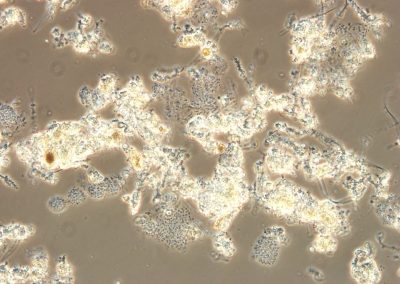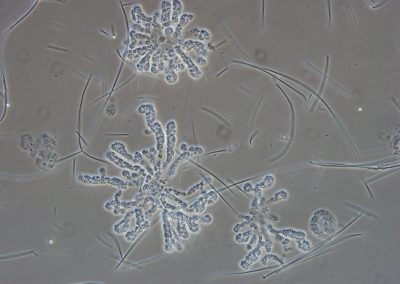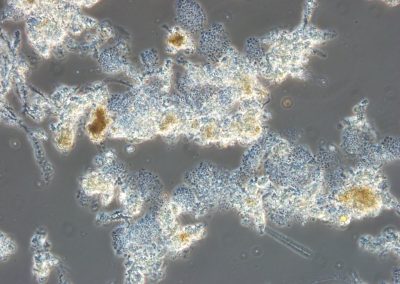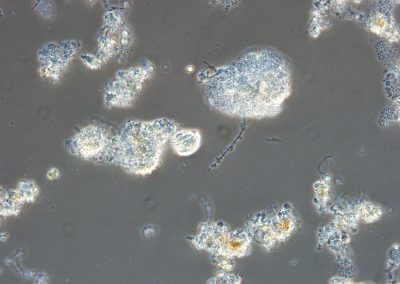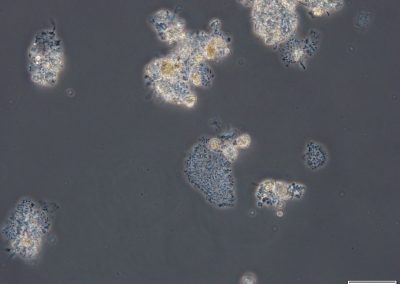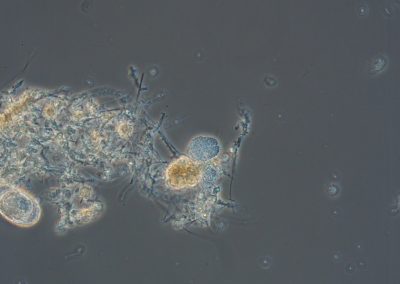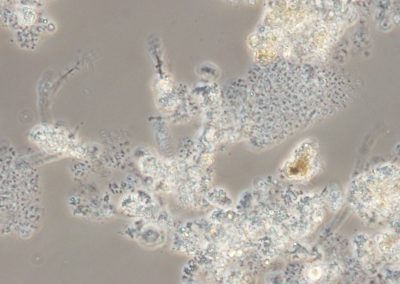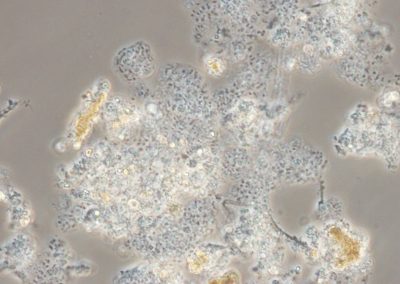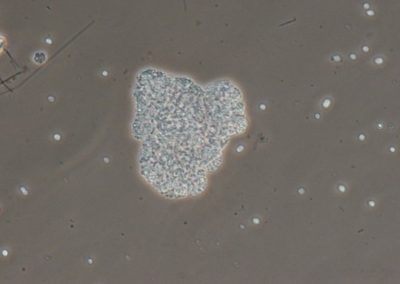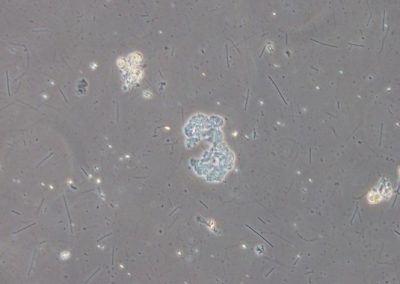Microbiology Gallery
Trying to determine what you might be seeing under the microscope and whether it is good or bad? The following categories of microorganisms are seen in wastewater treatment to varying degrees in every plant. While the single-celled bacteria are those that reduce BOD, the presence or absence of these “higher life forms” can communicate the health or change in the health of the biological wastewater process. Click on the category for a brief description and photomicrographs taken at EBS representing those organisms. If you have any questions on what your system is showing or experiencing, the EBS laboratory team will be pleased to assist you in this area.
Algae
Algae are common in waste treatment systems and come in many forms, including a filamentous form. They are usually green or brown in color and the filaments are larger than bacterial filaments. Some have flagella and are sometimes classified as flagellated algae. Many of the algae types are mobile and can be observed swimming through the water with little magnification. Some have a red “eyespot”, a small red spot in the center of the organism, used to indicate light for photosynthesis. While they all utilize photosynthesis, many can also conduct carbonaceous respiration and, therefore, are excellent BOD degraders.
Algae are usually indicative of excess nutrients in a system and can follow an upset that kills the bacterial cells thus releasing the bound nutrients. They are more common in the summer months when there is more sunlight, warmer water, and increased benthic feedback of nutrients. In large numbers, they can cause elevated TSS at the effluent.
Amoeba
Amoebae range in size from 100 to 300 micrometers. They are unique in that they have no distinct shape. They continually range from round to oval to irregular shapes with protrusions periodically extending from the main cell mass and then withdrawing. They move by the use of foot-like protrusions called pseudopodia (false feet). A pseudopodia is pushed out and the main cell mass moves by flowing into the extended portion. They are sometimes harder to detect because they usually move extremely slowly.
Bare, or naked, amoebae are commonly found during startups or in heavily loaded plants. Testate, or shelled, amoebae will usually indicate a stable, lightly loaded wastewater system.
Free Swimming Ciliate and Crawling Ciliates
The ciliates are so named because of the cilia, small hairs that are distributed over the entire body. Ciliates are generally ovoid or pear-shaped and maintain their shape by means of a tough but flexible pellicle. Cilia protrude through the pellicle in a variety of patterns. The term ciliate comes from the Latin word “ciliate” which means eyelash.
Free-swimming ciliates range in size from 40-100 micrometers. Rapid, rhythmic cilia movement propels them through the liquid. Some are completely covered with cilia while others have cilia in rows or spirals around the cell. Euplotes, Colpidium, and Paramecium are common examples of free-swimming ciliates.
Some ciliates have specialized cilia that look and function like legs, allowing them to crawl around on floc particles and “flick” up the bacteria so that they can consume them. These are called crawling ciliates and tend to stay on the floc more than free in the bulk water. Aspidisca is one example of a crawling ciliate. The main purposes of their cilia are to propel the organisms and to gather food into their mouths (cytostome). They feed mostly on bacteria and other single-cell organisms. They are sometimes identified by their smooth gliding or “swimming” motion through a sample or by the “crawling” movements around a piece of floc.
Ciliates are typical colonizers of biological sludge. Under optimum conditions, their numbers range from 1,000 to100,000 cells/mL. A sudden reduction in the number of individuals, or occurrence of encysted, inflated, or dead ciliates, is an indication of shock loading with toxic substances or organic overloading. Therefore they are indicators of toxicity in wastewater systems such as ASB’s or Activated Sludge. Since they move fast and they prey on bacteria, ciliates help to produce a low TSS and turbidity effluent. Some plants use the presence of ciliates to predict the quality of the plant’s effluent.
Stalked Ciliates
Stalked ciliates can be seen in single organism form or can grow in colonies. Each “head” in a colony of stalked ciliates is considered one organism. Therefore, when counting higher life forms for maturity index calculations every organism is counted in the colony. Colonies can range from three to over three hundred organisms each. Stalked ciliates usually attach themselves to a piece of floc or inert material but can occasionally be seen moving through the water, with or without the stalk. Centrifuging a sample for observation can break the stalk off. Each species resembles a tulip or tube shape with cilia (small hairs) around the opening. The cilia trap bacteria, which are used as a food source, by creating a current that moves the bacteria toward the opening. The stalk ciliate then contracts in a quick motion, which pushes the food into the body where it can be utilized.
Stalked ciliates usually indicate a stable, healthy system with a moderate to high maturity index. Because stalked ciliates attach to pieces of floc, they usually imply that the biomass (bacteria) is forming well-structured floc that is essential to settling and good effluent quality. However, one stalked ciliate, Vorticella microstoma, is often indicative of high turbidity and poor effluent quality. This is because they consume single bacteria cells in open water which means dispersed bacteria are present and turbidities are elevated. But, this particular stalked ciliate has a very small mouth opening compared to other species which enables them to be identified fairly easily.
Chaetonotus
Chaetonotus is a group of poorly understood metazoans. Their size range overlaps that of ciliates, with which they are often confused because of the cilia and spines. They are distinguished by two adhesive structures, like a forked tail, at the posterior end of the cell and by the presence of a discrete pharynx. They usually glide rather than swim. Chaetonotus are sensitive to hostile conditions and only appear when treatment conditions are stable.
Flagellate
Flagellates belong to the class Mastigophora and range in size from 5-20 micrometers in diameter. They are commonly ovoid or pear-shaped with one to four flagella, hair-like projections used for locomotion, attached to one or both ends of the cell. The flagella can usually be observed at 1000X magnification. Some flagellates may form colonies in which the cell bodies are clumped together with their flagella projecting outward. Some flagellates contain chlorophyll and are capable of photosynthesis. Due to the particular characteristic of resembling plants, they are often classified as flagellated algae rather than protozoa.
The locomotion of flagellates is usually fast and they seem to flip and twist as the flagella are “whipped” around to propel them. Some flagellates have multiple flagella. This makes them appear “bouncy” and unorganized due to their locomotion mechanism while other higher life forms such as free-swimming ciliates present a more organized locomotion mechanism. This is sometimes helpful in identifying flagellates under the microscope. When counting flagellates under the microscope, a 400X magnification should be used in order to identify them better due to their small size.
Flagellates feed on soluble organic matter and dispersed bacteria. Flagellates are more common in heavily loaded plants or during startups. They predominate when there is a high dispersed (single-celled) bacteria population density. They are sometimes associated with turbid effluents produced during toxic upsets. They also bloom when septic sludge or inadequate aeration causes anaerobic conditions in the aeration basin. Their presence in a wastewater treatment system indicates high soluble biochemical demand levels, low dissolved oxygen, and high organic load. Typically higher life forms disappear when a chemical upset goes through a wastewater system. Flagellates are the first higher life form to come back after a chemical upset in the wastewater system. Flagellates can indicate when the wastewater system is getting healthier or if it is still overcoming a chemical upset.
Nematode
Nematodes are common and widespread metazoa. Most are 2-3 mm long and have a long thin shape and a slightly blunt anterior end, resembling earthworms. They are rather stiff and can move either by writhing or gliding through a substrate. At high magnification, a strong muscular pharynx is apparent near the front and egg-bearing ovaries near the back end. Nematodes occur in lightly loaded plants operated at a low F/M (food to mass) ratio. They are commonly found in old activated sludge with ample dissolved oxygen and in biofilm reactors. They can be used as a type of bioindicator for determining when toxins have been introduced into a system. Their burrowing action promotes floc health by allowing oxygen to penetrate the larger pieces of floc.
Purple Sulfur Bacteria
The purple sulfur bacteria belong to the phylum Proteobacteria. These bacteria are often found in stagnant waters or where there are high concentrations of Hydrogen Sulfide. In order to conduct photosynthesis, they need anoxic conditions, which means that they cannot survive where there are high dissolved oxygen concentrations. They are easily identified under the microscope since their particular shape resembles that of “Chex-Mix” snacks. They take the hydrogen sulfide from the water column and metabolize it into granules of elemental sulfur. These sulfur granules may be oxidized to form sulfuric acid. Also, the sulfur granules can be easily seen within the bacterial cells at a 1000x wet mount microscopic slide. In high numbers, these bacteria give the water and the floc a pink or purplish tint. Generally, they are indicators of septicity, and in severe cases, the dispersed purple sulfur bacteria can cause high effluent Total Suspended Solids levels. In the Pulp and Paper Mill industry, purple sulfur bacteria can be helpful in identifying septic zones which is no other than an indication of poor dissolved oxygen concentrations in different sections of a wastewater treatment system. Although they can be helpful in identifying certain problems within wastewater treatment systems, purple sulfur bacteria are not principal Biochemical Oxygen Demand (BOD) degraders and makes them more of a problem within the system when present in high numbers. In order to control purple sulfur bacteria in a wastewater system, it is important to maintain good dissolved oxygen conditions in the wastewater system. This is effectively achieved with the installation of aeration devices in areas where the dissolved oxygen concentrations seem to decrease significantly in the wastewater system. Another way of controlling purple sulfur bacteria is by the addition of oxidizing agents such as hydrogen peroxide or nitrate salts. They are more prevalent in the summer months due to higher temperatures.
Rotifers
Rotifers are metazoa and are the simplest of multicellular animals. They are found in many different types of water including aeration stabilization basin systems, activated sludge, and some freshwater systems. Rotifers range in size from 40 to 500 µm. They are, in fact, microscopic crustaceans. Rotifers move by swimming freely through the bulk water or crawling. They have a ciliated area at the anterior end (mouth opening) that resembles a “rotating wheel.” This group of cilia at the mouth aids in the feeding and movement of the rotifer. They feed on suspended particles and bacteria. The food is passed into the gut via two grinding plates called “mastax”. Many rotifers also have a posterior podite (foot) which allows them to attach to floc. It usually looks like a forked tail. The main role of rotifers in wastewater systems is the removal of bacteria. They also aid in floc formation. Rotifers thrive in conditions with plenty of oxygen and are an indicator species for low Biochemical Oxygen Demand (BOD), low toxicity, and stable wastewater systems.
They are the most abundant macroinvertebrates in an activated sludge system. In the activated sludge system, rotifers have shown to be helpful in reducing bulking by preying on the filamentous bacteria “Microthrix” which is associated with bulking in wastewater systems. They are mostly found in very stable activated sludge systems. They are excellent indicators of the health of the sludge and suggest whether the sludge is of good quality, is stable, and has plenty of oxygen or not. They are also beneficial to the wastewater system because they stabilize the organic waste, enhance oxygen penetration into the floc, and recycle mineral nutrients. They contribute to floc formation and reduction of final effluent turbidity by removing (consuming) non-flocculated bacteria. Since they are more predominant in older sludge, some wastewater plants use rotifers to identify whether they need to increase wasting.
Sphaerotilus Natans
Sphaerotilus natans, S. natans for short, is a type of filamentous bacteria found in many activated sludge processes and in aerated stabilization basins (ASBs). It is commonly found in systems where there is a low dissolved oxygen concentration, nutrient deficiency, especially phosphorus, and/or in the presence of soluble, readily-metabolizable substrates, like organic acids or simple sugars. It is also common in complete mix systems where the wastewater and biomass are completely mixed throughout the aeration basin.
S. natans should be identified by filamentous bacteria identification by trained personnel. By using activated sludge microscopic examination techniques, microbiologists will look for the following characteristics of this filament: straight or smoothly-curved trichomes that extend from the floc and resemble spaghetti, sausage-shaped rods or round-ended rods, clear cell septa, and a tight sheath. The filament length ranges from 100 to greater than 500 microns in length and around 1.5 microns in diameter. Because of the long length of these filaments, they can cause filamentous bridging of the floc or open floc structure. The filament is not motile and usually does not have attached growth unless is it not growing. If attached growth is present, it is not substantial. S. natans has Gram and Neisser negative staining reactions. It presents itself with false branching, where the filaments appear to be branched but are actually just lying very close together. In this case, there is no continuous flow of cytoplasm between the two filaments. While many filaments can metabolize sulfates and incorporate them as elemental sulfur in the cells, this filament does not contain sulfur granules.
S. natans can cause filamentous bulking sludge in industrial wastewater treatment plants that contain easily degradable materials, like sugars or organic acids. It can be temporarily controlled by chlorination of the filaments and concurrent wasting. However, the root cause for the bulking has to be corrected to prevent the filament from returning. During chlorination, empty sheaths or empty cells are observed within the filaments. Bulking episodes are identified by microscopic examination and settling analyses.
Suctoria
Suctoria is commonly found in wastewater systems as well as marine and freshwater systems. The family is often periphytic (attached to the substrate) or attached to aquatic invertebrates. The feeding spines can be all over the body or arranged in two groups on either side of the triangular body. Suctoreans are predatory using their spines to capture other higher life forms and suck out the nutrient-rich cytoplasm of the captured organism. Suctoreans comprise approximately 7% of all ciliates described to date and are a very diverse group of higher organisms. They range in size from 40 to 200 m. The majority of Suctoreans are non-colonial. During adverse environmental conditions, Suctoria will break away from the stalk to seek out a more favorable habitat. During this stage, the morphology changes, where the body reabsorbs the spines and extends cilia in order to move freely in the water. After locating a favorable substrate, it reverts to its more common morphology. Mature Suctoria, in their stalked morphology, are indicative of stable, healthy biomass that is lightly loaded and well-oxygenated.
Water Flea
Water fleas are small, aquatic crustaceans. They live in various environments from swamps to freshwater lakes, ponds, streams, and rivers. The most common water flea is the genus Daphnia. The water flea gets its name because of the way it swims. They are usually seen in the spring. Water fleas are an indicator species, particularly Daphnia Pulex. It is one of the organisms used in biological toxicity testing. Therefore when you see water fleas in your system, it is an indication that your system is very clean and not harmful to the environment because they are very sensitive to toxins such as bleaching agents, metal ions, and many others.
Zoogloea
Once thought to be the only floc-forming bacteria, this “classical floc-former” exists in 2 forms within activated sludge, fingered Zoogloea and amorphous Zoogloea. Fingered Zoogloea have many branches that look like “fingers” and resemble the pseudopodia (false feet) of amoebae. These organisms may proliferate in activated sludge to the extent that sludge settling is hindered (Zoogloeal bulking). Large masses of this dendritic form may physically interfere in sludge settling and compaction similar to filamentous bulking. Excessive Zoogloea is usually the result of a high F/M (food-to-microorganism ratio), especially when the wastes contain soluble, readily degraded organic compounds such as soluble sugars or simple organic acids (from septic areas). Nutrient deficiency can also be a factor, leading to slime bulking. When insufficient nitrogen and/or phosphorus are available to produce necessary cell components (such as proteins), substantial amounts of exocellular polysaccharides (“slime”) are produced. This jelly-like consistency to the activated sludge can interfere with sludge compaction.
